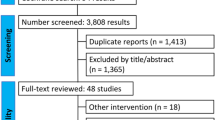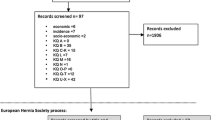Abstract
Purpose
Incisional hernia (IH) has an incidence of 10–23%, which can increase to 38% in specific risk groups. The objective of this study is to report the results at 3 years of follow-up of the use of the reinforced tension line (RTL) technique compared with primary suture only (PSO) closure in the prevention of IH in high-risk patients undergoing laparotomy.
Methods
Open randomized controlled clinical trial. Included were patients older than 18 years who underwent midline laparotomy, emergency or scheduled, who were considered high risk, and who completed 3-year follow-up. The patients were randomized 1:1 to the RTL technique or to PSO. The objective was to report the incidence of IH and the complications associated with the closure method. Intention-to-treat analysis and Cox regression were performed.
Results
A total of 124 patients were randomized; 51 patients from the RTL group and 53 patients from the PSO group finished the 3-year follow-up. The incidence of IH was higher in the PSO group (15/53, 28.3%) than the RTL group (5/51, 9.8%) (p = 0.016, OR 0.35, 95% CI 0.14–0.88, number needed to treat 5.4, log-rank test p = 0.017). The groups were similar in the rates of surgical site infection, hematoma, seroma, and postoperative pain during follow-up.
Conclusions
The RTL technique is useful in the prevention of IH when compared with PSO in high-risk midline laparotomy patients, and it is not associated with a higher percentage of complications.
Trial registration
Local Committee CI-HRAEB-2013-020. March 13, 2013.
Clinical trials
NCT02136628, retrospectively registered.



Similar content being viewed by others
Data availability
The database is available for review.
References
Deerenberg EB, Harlaar JJ, Steyerberg EW et al (2015) Small bites versus large bites for closure of abdominal midline incisions (STITCH): a double-blind, multicenter, randomized controlled trial. Lancet 386:1254–1260
Jairam AP, Timmermans L, Eker HH, PRIMA Trialist group et al (2017) Prevention of incisional hernia with prophylactic onlay and sublay mesh reinforcement versus primary suture only in midline laparotomies (PRIMA): 2-years follow-up of a multicenter, double blind, randomized controlled trial. Lancet 390(10094):567–576. https://doi.org/10.1016/S0140-6736(17)31332-6
Harris HW, Hope WH, Adrales G, Andersen DK, Deerenberg E et al (2018) Contemporary concepts in hernia prevention: selected proceedings from the 2017 international simposium of prevention of Incisional Hernia. Surgery. https://doi.org/10.1016/j.surg.2018.02.020
Khorgami Z, Shoar S, Laghaie B, Aminian A, Araghi NH et al (2013) Prophylactic retention sutures in midline laparotomy in high-risk patients for wound dehiscence: a randomized controlled trial. J Surg Res 180:238–243. https://doi.org/10.1016/j.jss2012.05.012
Thorup T, Tolstrup MB, Gögenur I (2019) Reduced rate of incisional hernia after standardized fascial closure in emergency laparotomy. Hernia 23:341–346. https://doi.org/10.1007/s10029-019-01893-0
De Beaux AC (2019) Abdominall wall closure. BJS 106:163–164. https://doi.org/10.1002/bjs.11081
Ponce LF, Manso JEF, Abud VL, Nogueira W, Martinez R (2018) Sublay repair results in superior mesh incorporation and histological fibrogenesis in comparison to onlay and primary suture in a experimental rat model. Hernia 22:1089–1100. https://doi.org/10.1007/s10029-018-1808-y
Payne R, Aldwinckle J, Ward S (2017) Meta-analysis of randomized trials comparing the use of prophylactic mesh to standard midline closure in the reduction of incisional herniae. Hernia 21:843–853
San Miguel C, Melero D, Jimenez E, Lopez P et al (2018) Long-term outcomes after prophylactic use of onlay mesh in midline laparotomy. Hernia 22:1113–1122. https://doi.org/10.1007/s10029-018-1833-x
Glauser PM, Brosi P, Speich B, Käser SA, Heigl A et al (2019) Prophylactic intraperitoneal onlay mesh following midline laparotomy-long-term results of a randomized controlled trial. World J Surg 43(7):1669–1675. https://doi.org/10.1007/s00268-019-04964-6
Caro-Tarrago A, Olona C, Millan M, Olona M, Espina B, Jorba R (2019) Long-term results of a prospectiv randomized trial of midline laparotomy closure with onlay mesh. Hernia 23:335–340
Kohler A, Lavanchy JL, Lenoir U, Kurmann A, Candinas D, Beldi G (2019) Effectiveness of prophylactic intraperitoneal mesh implantation for prevention of incisional hernia in patients undergoing open abdominal surgery: a randomized clinical trial. JAMA Surg 154(2):109–115
Lima HVG, Rasslan R, Novo FCF, Lima TMA, Damous SHB et al (2020) Prevention of fascial dehiscence with onlay prophylactic mesh in emergency laparotomy: a randomized clinical trial. J Am Coll Surg 230:76–87. https://doi.org/10.1016/j.jamcollsurg.2019.09.010
Fischer JP, Harris HW, Lopez Cano M, Hope WW (2019) Hernia prevention: practice patterns and surgeons´attitudes about abdominal wall closure and the use of prophylactic mesh. Hernia 23:329–334. https://doi.org/10.1007/s10029-019-01894-z
Warren J, Desai SS, Boswell ND, Hancock BH, Abbad H, Ewing JA, Carbonell AM, Cobb WS (2020) Safety and efficacy of synthetic mesh for ventral hernia repair in a contaminated field. J Am Coll Surg 230(4):405–413. https://doi.org/10.1016/j.jamcollsurg.2019.12.008
Dumanian GA, Lanier ST, Souza JM, Young MW, Mlodinow AS et al (2018) Mesh sutured repairs of contamined incisional hernias. Am J Surg 216(2):267–273. https://doi.org/10.1016/j.amjsurg.2017.10.025
Lozada-Hernández EE, Mayagoitia-Gonzalez JC, Smolinski-Kurek R, Alvarez-Canales JJ, Montiel-Hinojosa L et al (2016) Comparación de dos técnicas de sutura para cierre aponeurótico en laparotomía media en pacientes con alto riesgo de evisceración posquirúrgica. Rev Hispanoam Hernia 4(4):137–143. https://doi.org/10.1016/j.rehah.2016.08.001
Van Ramshorst GH, Nieuwenhuizen J, Hop WC, Arends P, Boom J, Jeekel J, Lange JF (2010) Abdominal wound dehiscence in adults: development and validation of a risk model. World J Surg 34(1):20–27. https://doi.org/10.1007/s00268-009-0277-y
Gómez Díaz CJ, Rebasa Cladera P, Navarro Soto S, Hidalgo Rosas JM, Luna Aufroy A, Montmany Vioque S, Corredera Cantarín C (2014) Validación de un modelo de riesgo de evisceración [Validation of abdominal wound dehiscence's risk model]. Cir Esp 92(2):114–119. https://doi.org/10.1016/j.ciresp.2012.12.008 (Spanish)
Hollinsky C, Sandberg S (2007) A biomechanical study of the reinforced tension line (RTL)–a technique for abdominal wall closure and incisional hernias. Eur Surg 39:122–127. https://doi.org/10.1007/s10353-006-0304-2
Hollinsky C, Sandberg S, Kocijan R (2007) Preliminary results with the reinforced tension line: a new technique for patients with ventral abdominal wall hernias. Am J Surg 194(2):234–239. https://doi.org/10.1016/j.amjsurg.2006.09.045
Muysoms FE, Antoniou SA, Bury K, Campanelli G, Conze J, Cuccurullo D, de Beaux AC, Deerenberg EB, East B, Fortelny RH, Gillion JF, Henriksen NA, Israelsson L, Jairam A, Jänes A, Jeekel J, López-Cano M, Miserez M, Morales-Conde S, Sanders DL, Simons MP, Śmietański M, Venclauskas L, Berrevoet F, European Hernia Society (2015) European Hernia Society guidelines on the closure of abdominal wall incisions. Hernia 19(1):1–24. https://doi.org/10.1007/s10029-014-1342-5
Webster C, Neumayer L, Smout R, Horn S, Daley J, Henderson W, Khuri S, National Veterans Affairs Surgical Quality Improvement Program (2003) Prognostic models of abdominal wound dehiscence after laparotomy. J Surg Res 109(2):130–137. https://doi.org/10.1016/s0022-4804(02)00097-5
Veljkovic R, Protic M, Gluhovic A, Potic Z, Milosevic Z, Stojadinovic A (2010) Prospective clinical trial of factors predicting the early development of incisional hernia after midline laparotomy. J Am Coll Surg. 210(2):210–219. https://doi.org/10.1016/j.jamcollsurg.2009.10.013
Goodenough CJ, Ko TC, Kao LS, Nguyen MT, Holihan JL, Alawadi Z, Nguyen DH, Flores JR, Arita NT, Roth JS, Liang MK (2015) Development and validation of a risk stratification score for ventral incisional hernia after abdominal surgery: hernia expectation rates in intra-abdominal surgery (the HERNIA Project). J Am Coll Surg 220(4):405–413. https://doi.org/10.1016/j.jamcollsurg.2014.12.027
Cherla DV, Moses ML, Mueck KM, Hannon C, Ko TC, Kao LS, Liang MK (2017) External validation of the HERNIAscore: an observational study. J Am Coll Surg 225(3):428–434. https://doi.org/10.1016/j.jamcollsurg.2017.05.010
Fischer JP, Basta MN, Mirzabeigi MN, Bauder AR, Fox JP, Drebin JA, Serletti JM, Kovach SJ (2016) A risk model and cost analysis of incisional hernia after elective, abdominal surgery based upon 12,373 cases: the case for targeted prophylactic intervention. Ann Surg 263(5):1010–1017. https://doi.org/10.1097/SLA.0000000000001394
Basta MN, Kozak GM, Broach RB, Messa CA 4th, Rhemtulla I, DeMatteo RP, Serletti JM, Fischer JP (2019) Can we predict incisional hernia?: Development of a surgery-specific decision-support interface. Ann Surg 270(3):544–553. https://doi.org/10.1097/SLA.0000000000003472
Lozada-Hernandez EE, Gonzalez-Gonzalez MA, Molina-Rodriguez JF, Obregon-Moreno E, Jimenez-Herevia AE, Cano Rosas M (2019) Comparison of two predictive scores for the development of incisional hernia. J Surg 6:188–193. https://doi.org/10.11648/j.js.20190706.17
Hernández-Granados P, López-Cano M, Morales-Conde S, Muysoms F, García-Alamino J, Pereira-Rodríguez JA (2018) Incisional hernia prevention and use of mesh. A narrative review. Cir Esp 96(2):76–87. https://doi.org/10.1016/j.ciresp.2018.01.003 (English, Spanish)
Yheulon C, Davis SS Jr (2019) Adopting the STITCH trial: crossing the chasm from publication to practice. JAMA Surg 154(12):1087–1088. https://doi.org/10.1001/jamasurg.2019.3358
Funding
Not applicable.
Author information
Authors and Affiliations
Contributions
EELH, the lead author, designed the study. JCMG conducted all the interviews and, alongside EELH, undertook the thematic analysis; RLSK, LMH, JMMV, LHV, KDPS, AOM and MCR took part in the schematic analysis. All authors have provided input into drafts of this article. All authors had full access to all the data in the study and had final responsibility for the decision to submit for publication. All authors have read and approved the manuscript in its final state.
Corresponding author
Ethics declarations
Conflict of interest
The authors declare that they have no conflict of interest.
Ethics approval
Our study complies with the Code of Ethics of the World Medical Association (Declaration of Helsinki) and the study was approved by the local committee for clinical research and the ethics committee.
Human and animal rights
This article does not contain any studies with animals performed by any of the authors.
Consent to participate
At recruitment, written informed consent was obtained from each subject.
Consent for publication
According to the study publication.
Additional information
Publisher's Note
Springer Nature remains neutral with regard to jurisdictional claims in published maps and institutional affiliations.
Electronic supplementary material
Below is the link to the electronic supplementary material.
Rights and permissions
About this article
Cite this article
Lozada-Hernández, E.E., Mayagoitía-González, J.C., Smolinski-Kurek, R.L. et al. Prevention of incisional hernia with a reinforced tension line (RTL) versus primary suture only in midline laparotomies: 3-year follow-up in a randomized clinical trial. Hernia 26, 447–456 (2022). https://doi.org/10.1007/s10029-020-02338-9
Received:
Accepted:
Published:
Issue Date:
DOI: https://doi.org/10.1007/s10029-020-02338-9




